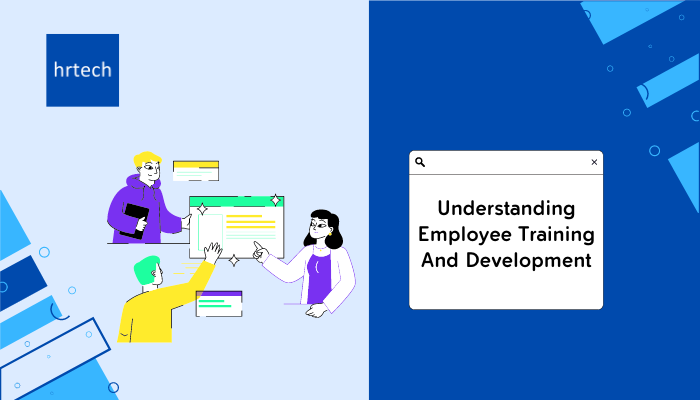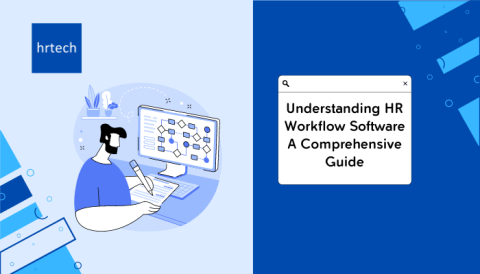Did you know that 94% of employees highlighted that they won’t leave a company which has the right training and development systems in place?
In this guide, we’ll cover all the essential details about employee training and development, including its benefits, methodologies, and types.
Plus, we’ll also share tips on implementing it, along with challenges, solutions, and real-world examples.
Ready? Let’s go…
Introduction To Employee Training And Development:

Employee training and development is a crucial aspect of any organization’s success. It involves providing employees with the skills, knowledge, and abilities they need to perform their jobs effectively and efficiently.
What Is Employee Training And Development?
Employee training focuses on teaching employees the skills they need to do their jobs. This can include technical skills, such as using a particular software program, or soft skills, such as communication and teamwork.
On the other hand, employee development is a broader concept that involves helping employees grow and advance in their careers over the long term. This can include providing opportunities for learning, mentoring, and career planning.
Strategic Importance Of Employee Development:
Investing in employee development is a strategic decision that can help organizations stay competitive in today’s fast-paced business environment.
Did you know? Research shows that companies that offer comprehensive training programs have a 218% increase in income per employee than companies that don’t offer any formalized training.
It’s also important to learn about the difference between training and development.
Effective employee training and development programs can help organizations attract and retain top talent.
Moreover, well-trained employees are more productive, engaged, and loyal to their organizations. Let’s examine the benefits of employee training and development in detail.
Benefits Of Training And Developing Employees:
1. Growing A Happy, Loyal, And Hard-Working Team
Employees who feel that their company is investing in their growth and development are likelier to be engaged and committed to their work.
This leads to higher job satisfaction, lower turnover rates, and improved performance.
2. Sparking Creativity and Overcoming Challenges
Training and development programs help employees learn new skills and think creatively. This can lead to innovative ideas and solutions that can give the company a competitive edge.
At the same time, these programs can also help identify and tackle individual and organizational weaknesses, leading to a stronger workforce.
3. Becoming A Magnet For Top Talent
Companies that are known for investing in their employee’s growth and development tend to have a better reputation and are more attractive to potential hires.
This can help the company attract top talent and build a strong employer brand.
4. Building a Culture Where Learning Never Stops
Making training and development a priority creates a culture where learning is valued and highly encouraged.
This leads to a more adaptable and flexible team that is better prepared to handle change and take on new challenges.
5. Enhancing Communication And Collaboration
Training programs focusing on communication and teamwork skills can help employees work together more effectively and efficiently.
And as a result, you can expect better project outcomes and a more positive work environment.
6. Improving Customer Satisfaction
Well-trained employees better understand and meet customer needs, leading to higher levels of customer satisfaction and loyalty.
This further leads to increased sales and revenue for the company.
7. Reducing Mistakes And Getting Things Right
Proper training can help employees perform their jobs more safely and accurately, reducing the risk of errors.
This can save the company money in the long run by avoiding costly mistakes.
8. Helping Employees Feel Valued And Supported
When companies invest in their employees’ growth and development, it sends a message that they are valued and supported.
This can lead to higher levels of employee morale and loyalty, leading to better performance and lower turnover rates.
9. Preparing Employees For Leadership Roles
Leadership development programs can help identify and train leaders within the organization. This helps the company build a strong pipeline of future leaders.
10. Staying Ahead In Your Market
In today’s competitive business market, companies that don’t invest in their employees’ skills and knowledge risk falling behind their competitors. By prioritizing training and development, companies can stay ahead of the curve.
Transforming HR through Agile Workforce Solutions
Essence And Types of Employee Training and Development
Employee training and development is all about helping workers learn new skills and grow in their jobs.
Companies can use many different types of training programs to support their employees’ growth and success.
1. Leadership Training
Companies often provide leadership training to help employees develop the skills they need to take on management roles in the future.
This training type covers topics like motivating and inspiring teams, making tough decisions, and communicating effectively.
2. Sales training
For employees in sales roles, training on sales techniques, product knowledge, and customer relationship management is crucial.
Sales training helps employees learn how to identify customer needs, present products and services effectively, and close deals.
3. Technical Skills Training
This type of training focuses on teaching employees the specific technical skills they need to do their jobs, like how to use a particular software program or operate a piece of equipment.
For example, a sales representative might receive training on how to use a customer relationship management (CRM) system to manage their sales pipeline and customer interactions better.
4. Compliance Training
Depending on the industry, companies may be required to provide training on specific laws and regulations, like workplace safety or data privacy.
Compliance training ensures that employees understand and follow these important rules.
5. Soft Skills Training
Soft skills are personal qualities that help employees work well with others and succeed in the workplace, like communication, teamwork, and problem-solving.
Companies often provide training on these skills to help employees build strong relationships with coworkers and customers.
6. Customer Service Training
For employees who interact with customers, customer service training is essential.
This type of training teaches employees how to communicate effectively with customers, handle complaints and questions, and provide excellent service that keeps customers coming back.
7. Diversity, Equity, And Inclusion Training
Many companies now offer training programs that help employees understand and value the differences among people based on background, race, age, etc.
These programs help in creating a workplace where everyone feels welcome and respected.
8. Onboarding Training
When new employees join a company, they need training to learn about the company’s culture, policies, and procedures.
Onboarding training helps new employees feel welcome and prepared to succeed in their new roles.
10. Project Management Training
Many employees, especially those in leadership roles, need to know how to manage projects effectively.
Project management training covers topics like planning, budgeting, and risk management, and helps employees develop the skills they need to lead successful projects from start to finish.
11. Conferences And Events
Companies often send employees to external conferences, seminars, and workshops to learn from industry experts, gain new insights, and network with peers.
These events can be focused on specific skills, like a marketing conference or a software development workshop, or more general topics like leadership or innovation.
12. Wellness Training
Recognizing the importance of employee well-being, many companies now offer training programs focused on physical and mental health.
These might include stress management workshops, healthy eating seminars, or fitness classes.
13. On-The-Job Training
OJT is a hands-on approach where employees learn new skills by working directly with more experienced colleagues or managers.
This type of training is often used for role-specific tasks, like learning how to operate a particular machine or follow a certain process.
OJT allows employees to learn in a real-world context and get immediate feedback from their trainer.
14. Corporate Training
This broad category of corporate training includes various training programs designed and delivered by the company itself, often through an internal training department or online learning platform.
Corporate training can cover a wide range of topics, from company-specific policies and procedures to general business skills like time management or data analysis.
The goal is to align employee skills and knowledge with the company’s goals and culture.
Approaches And Methods For Effective Employee Development:
There are many ways to help employees learn and grow in their jobs. Some common approaches includes:
Formal Education – Formal education involves sending employees to classes or workshops to learn new skills. For example, a company might pay for an employee to take a course on project management.
Assessment – Assessments help identify an employee’s strengths and areas for improvement. This could be a personality test or a skills assessment. The results can guide future training plans.
Job experience – Job experience is all about learning by doing. Employees can take on new tasks or projects to expand their skills. A marketing assistant could help plan a big event to gain event management experience.
Interpersonal relationships – Interpersonal relationships, like mentoring or networking, let employees learn from others.
Coaching – Coaching involves one-on-one guidance from a manager or expert. They give feedback and support to help the employee improve. Recent coaching industry report findings show that organizations implementing structured coaching programs see up to 70% improvement in employee performance and engagement.
Mentoring – Mentoring is a longer-term relationship where a more experienced employee shares advice and knowledge with a less experienced colleague.
Individual Development Plans (IDP) – IDPs are personalized plans that outline an employee’s goals and the steps to achieve them. The employee and their manager create the plan together.
9-Box Grid – The 9-Box Grid is a tool for assessing an employee’s current performance and future potential. It helps identify high-potential employees and areas for development. HR might use the grid to plan leadership training for top performers.
Cross Training – Cross-training involves teaching employees skills outside their normal job duties. This creates a more flexible workforce.
Job Enlargement – Job enlargement means adding more tasks at a similar level to an employee’s current role.
Job Shadowing – Job shadowing lets an employee observe someone in a different role to learn about their job.
Job Rotation – Job rotation moves employees through different roles or departments to expand their skills and understanding of the business. For instance, a sales representative could rotate through marketing, product development, and customer service.
Online Learning – Online learning platforms like Udemy or Coursera offer a wide range of courses employees can take at their own pace. For example, a graphic designer could take an online class on UX design.
AR/VR – Augmented reality (AR) and virtual reality (VR) create great training experiences. VR could be used to simulate a challenging customer service scenario. AR could guide a technician through a complex repair.
eLearning – eLearning modules are interactive online lessons employees can complete at their desk.
How To Design And Implement Successful Training Programs:
The first step to create a good training plan is to figure out what employees need to learn. Look at job descriptions, performance reviews, and company goals.
Ask employees and managers what training they think would help. This needs assessment helps make a training plan that works well for the company.
Next, set clear goals for what employees should learn and be able to do after training. Use these goals to plan the training. It might include classes, workshops, online courses, or practice on the job.
As employees go through training, check on their progress. Give short tests, watch them use new skills, or ask for feedback.
At the end, see if they met the learning goals. Also, keep track of things like productivity, mistakes, or customer happiness to see if training made work better.
Formal training is good, but it shouldn’t be the only way employees learn. Have experienced coworkers coach and guide them.
Urge employees to learn on their own too. Give them books, videos, or online courses. Let them practice new skills.
Make a workplace where everyone keeps learning and growing. Mix formal training with informal learning for the best results.
Use different types of training to keep employees interested. Options include:
Hands-on workshops
Online learning modules
Apps with short lessons
Virtual reality practice
Training while working
Learning skills in other departments
Challenging projects to build skills
Employees teaching each other
Switch it up and use different methods over time. Employees learn better when they use skills in many ways. Review key ideas to make lessons stick. Build a culture of always improving.
Training should give the company real results. Decide how to measure success before training starts. Options include:
Tests of what employees learned
Seeing if employees do their jobs differently
Improvements in quality, speed, sales, etc.
Scores of how engaged employees are
Keeping trained employees at the company
Look at these measurements before and after training. Figure out if the training was worth the money spent. If some programs aren’t working, make necessary changes as needed.
For further information, check out this in-depth guide on developing an effective employee training program.
Challenges and Solutions in Employee Training and Development:
Here are some common challenges and solutions in employee training and development:
1. Budgeting For Training:
Challenge: Many companies struggle to set aside enough money for employee training.
Solution: Create a clear budget for training.
2. Learning Preferences:
Challenge: Different age groups also have different learning styles and needs.
Solution: Offer a mix of training methods like online courses, mentoring, and hands-on practice to engage all ages.
3. Scalability:
Challenge: As companies grow, it gets harder to provide training to more employees.
Solution: Use learning management systems to assign and track training for large groups.
4. Accountability:
Challenge: Holding individuals responsible for applying what they learned can also be tough.
Solution: Set clear expectations and follow up with employees to ensure they use their new skills on the job.
5. Learning Styles:
Challenge: Traditional classroom training can be boring and may not stick with employees long-term.
Solution: Incorporate engaging technologies like mobile learning apps, and virtual reality simulations. Bite-sized lessons and interactive elements make training more memorable. Innovative approaches lead to better results.
6. Communication:
Challenge: Employees often find training communications confusing.
Solution: Use normal and easy to understand language in all training-related emails, presentations, and communication channels.
7. Compliance Consideration:
Challenge: Companies must also comply with many laws and regulations around employee development.
Solution: Work with the legal department to ensure training meets all requirements. Keep records showing that employees completed mandatory compliance training.
Examples Of Employee Training And Development:
Amazon:
Amazon has a comprehensive onboarding program that lasts a full month for new hires. They also offer the Career Choice Program, launched in 2012, which provides generous education support.
This includes covering up to 95% of tuition and fees for certificates or associate degrees up to $12,000.
In 2019, Amazon offered $700 million to retrain 100,000 employees, with a focus on helping non-technical workers gain technical skills through programs like the Amazon Technical Academy.
This prepares them for software engineering roles. Amazon emphasizes the value of certifications and creates many opportunities for workers to advance internally.
AT&T:
AT&T also provides strong educational benefits, including tuition assistance, internal training programs, and executive-led training through AT&T University.
They partner with top online learning platforms like Udacity to offer self-paced technical courses, and with Georgia Tech for an online Master’s in Computer Science program.
AT&T knows that supporting employee education helps them build the skilled workforce they need.
Accenture:
In 2021, Accenture invested $1 billion in reskilling their workforce. They have a connected learning platform that combines classroom and digital learning.
The platform includes content from both internal and external experts
Accenture focuses on connecting, collaborating, and practicing skills. Employees can learn anywhere, anytime. This approach promotes self-directed learning and career development.
These examples show how companies of different sizes and industries are prioritizing employee training and development.
Future Of Employee Training and Development:
As the world changes and the workforce grows, companies need to change how they train and develop their employees. Here are some important things to think about:
Understand the changing demographics and needs of your employees.
Offer flexible training options to accommodate different learning styles and schedules.
Use smart computer programs to make special training plans.
Include virtual reality (VR) and augmented reality (AR) in training programs to make learning more fun and interesting.
Use data analytics to track employee progress and optimize training programs.
Set clear goals and metrics for each training program.
Calculate the ROI of training programs based on improved productivity, reduced turnover, and increased revenue.
Speaking of future trends, you might also want to check out this guide on key talent acquisition and hiring trends for latest insights.
Conclusion:
Employee training and development is essential for organizations to remain competitive and build a strong flexible team.
Companies that invest in training programs for different types of learners, use technology, and focus on both short-term skills and long-term career growth can see better productivity, employee engagement, and retention.
Working with hrtech can also give you access to many helpful resources.
For instance, hrtech Academy has courses and programs to improve HR professionals’ skills. Whereas, our marketplace has the latest HR software solutions. And if you want to connect with skilled HR Professionals, then our Talent-on-Demand service is worth checking out.





